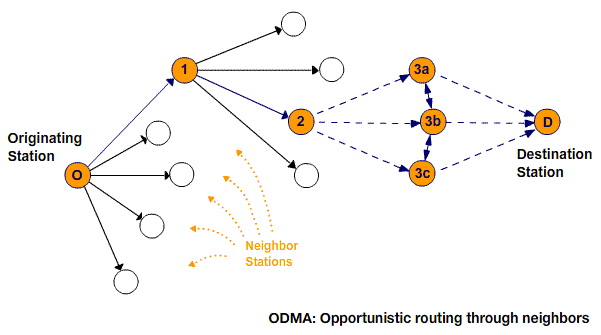|
|
 |
 |
 |
 |
 |
|
ODMA Technology: Basic Concepts
With the explosion of cellular phone use and Internet multi-media services, wireless networks are becoming increasingly congested. The increased demand has raised our expectations, while creating capacity problems and a need for greater bandwidth. However, if the transmitted power of wireless units is significantly reduced, then there is a potential solution. This implies a signal-to-noise ratio improvement: the ratio is affected by numerous parameters, including radio frequency and path. Opportunity Driven Multiple Access™ (ODMA™) continually determines optimal points along that path to support each transmission.
Adaptation
ODMA uses many adaptation techniques to optimize communications, but one of the most powerful is path diversity. From origin to destination, ODMA stations relay the transmissions in an intelligent and efficient manner.

Each Subscriber Builds the Network
The available optimal paths will increase as subscribers join the network, supporting a fundamental aspect of the ODMA philosophy: Communications are dynamic and local, best controlled at the station level, rather than from some centralized source. Each ODMA-network station is an intelligent burst-mode radio, which can use all the available bandwidth some of the time. However, as with any technology, weather or general network conditions can affect transmissions.
Efficiency with Sub-Bands
Like cellular networks, the ODMA-network stations operate in the same wide frequency band, but frequency hopping, at lower data rates, introduces sub-bands. Because transmission is packet based and connectionless, stations relay packets from neighbor stations. For each packet, a station optimizes the transmission by adapting the route, power, data rate, packet length, frequency, time window and data quality over a wide range. Each station has responsibility and much autonomy for routing and service-enhancing adaptation to the current environment. For security, stations accept the authority of a network supervisor.
|
|
|